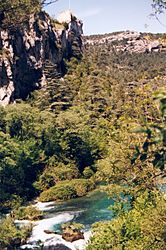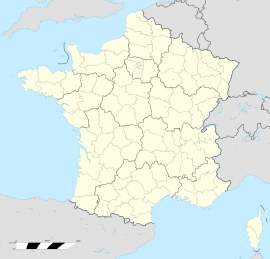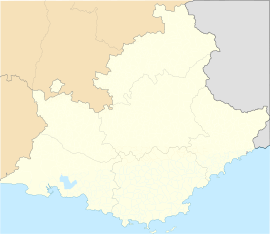Fontaine-de-Vaucluse facts for kids
Quick facts for kids
Fontaine-de-Vaucluse
|
||
|---|---|---|
 |
||
|
||
| Country | France | |
| Region | Provence-Alpes-Côte d'Azur | |
| Department | Vaucluse | |
| Arrondissement | Avignon | |
| Canton | Isle-sur-la-Sorgue | |
| Intercommunality | Pays des Sorgues et des Monts de Vaucluse | |
| Area
1
|
7.14 km2 (2.76 sq mi) | |
| Population
(2006)
|
685 | |
| • Density | 95.94/km2 (248.5/sq mi) | |
| Time zone | UTC+01:00 (CET) | |
| • Summer (DST) | UTC+02:00 (CEST) | |
| INSEE/Postal code |
84139 /84800
|
|
| Elevation | 68–652 m (223–2,139 ft) (avg. 80 m or 260 ft) |
|
| 1 French Land Register data, which excludes lakes, ponds, glaciers > 1 km2 (0.386 sq mi or 247 acres) and river estuaries. | ||
Fontaine-de-Vaucluse is a small, charming village in the south of France. It is famous for its amazing natural spring, which is one of the biggest in the world. This spring is the source of the Sorgue River. The village is located in the Vaucluse department, within the beautiful Provence-Alpes-Côte d'Azur region.
In 1999, about 610 people lived in this commune. A commune is like a small town or village with its own local government. Fontaine-de-Vaucluse is a popular spot for tourists because of its unique natural features and interesting history.
Contents
The Famous Spring of Vaucluse
The main attraction in Fontaine-de-Vaucluse is its incredible spring. This spring is the largest in France and the fifth largest in the world. It flows out from the bottom of a tall limestone cliff.
How the Spring Works
The spring is fed by rainwater that soaks into the ground. This water travels through a huge underground network of caves and channels. Scientists have explored these underground areas using special equipment. They found that the water comes from a very large area, covering about 1,100 square kilometers (420 square miles).
Water Flow and Levels
The amount of water flowing from the spring changes a lot throughout the year. In the dry summer months, the flow can be quite low. But after heavy rains or snowmelt in the mountains, the spring can become a powerful gush of water. It can release up to 90 cubic meters (3,200 cubic feet) of water per second!
History of Fontaine-de-Vaucluse
The area around Fontaine-de-Vaucluse has been inhabited for a very long time. People have lived here since ancient times, drawn by the reliable water source.
Ancient Times
Archaeologists have found tools and signs of human activity from the Stone Age. The Romans also settled here. They built structures and used the water from the spring.
Medieval Period
During the Middle Ages, a castle was built high above the village. This castle belonged to the Bishops of Cavaillon. Its ruins can still be seen today, overlooking the village and the spring. The village grew around the spring and the castle, becoming an important local center.
Francesco Petrarca's Connection
One of the most famous people connected to Fontaine-de-Vaucluse is the Italian poet Francesco Petrarca. He lived here in the 14th century. Petrarca was inspired by the beautiful scenery and the peaceful atmosphere of the valley. He wrote many of his famous poems while living near the spring. There is a museum and library in the village dedicated to him.
What to See and Do
Fontaine-de-Vaucluse offers several interesting places to visit. Besides the famous spring, you can explore the village itself.
The Village and Its Charm
The village has narrow streets, old stone houses, and small shops. You can find local crafts and souvenirs. Many restaurants offer traditional French food. It's a great place for a leisurely walk.
Museums and Attractions
- Museum-Library Francesco Petrarca: This museum celebrates the life and work of the famous poet. It shows how he lived and what inspired him.
- Paper Mill (Moulin à Papier): You can visit an old paper mill that still uses traditional methods to make paper. It's a fascinating look into the past.
- Santons Museum: This museum displays "santons," which are small, traditional clay figures from Provence. They are often used in Nativity scenes.
Images for kids
See also
 In Spanish: Fontaine-de-Vaucluse para niños
In Spanish: Fontaine-de-Vaucluse para niños












